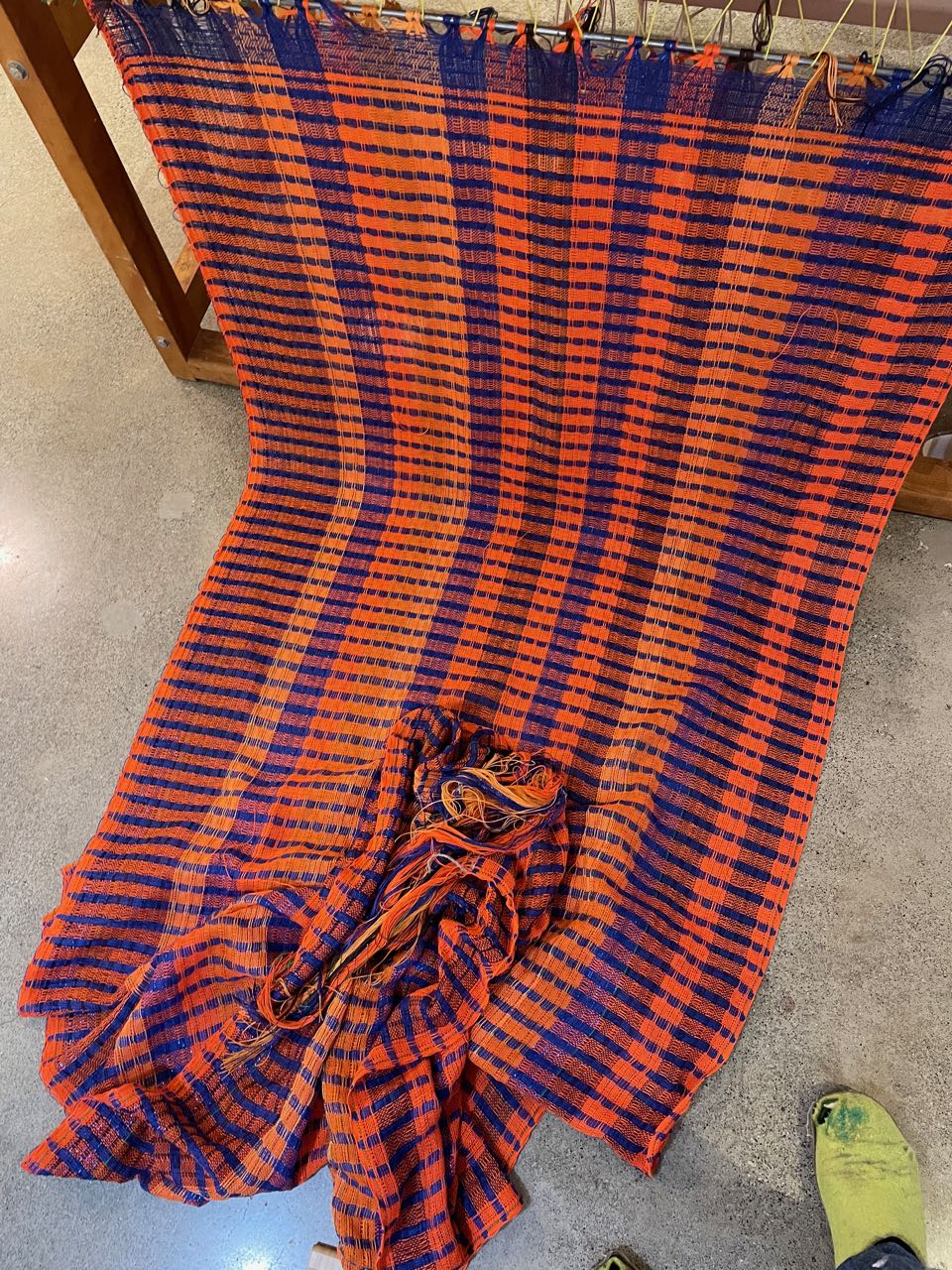November 30 - January 26th 2023
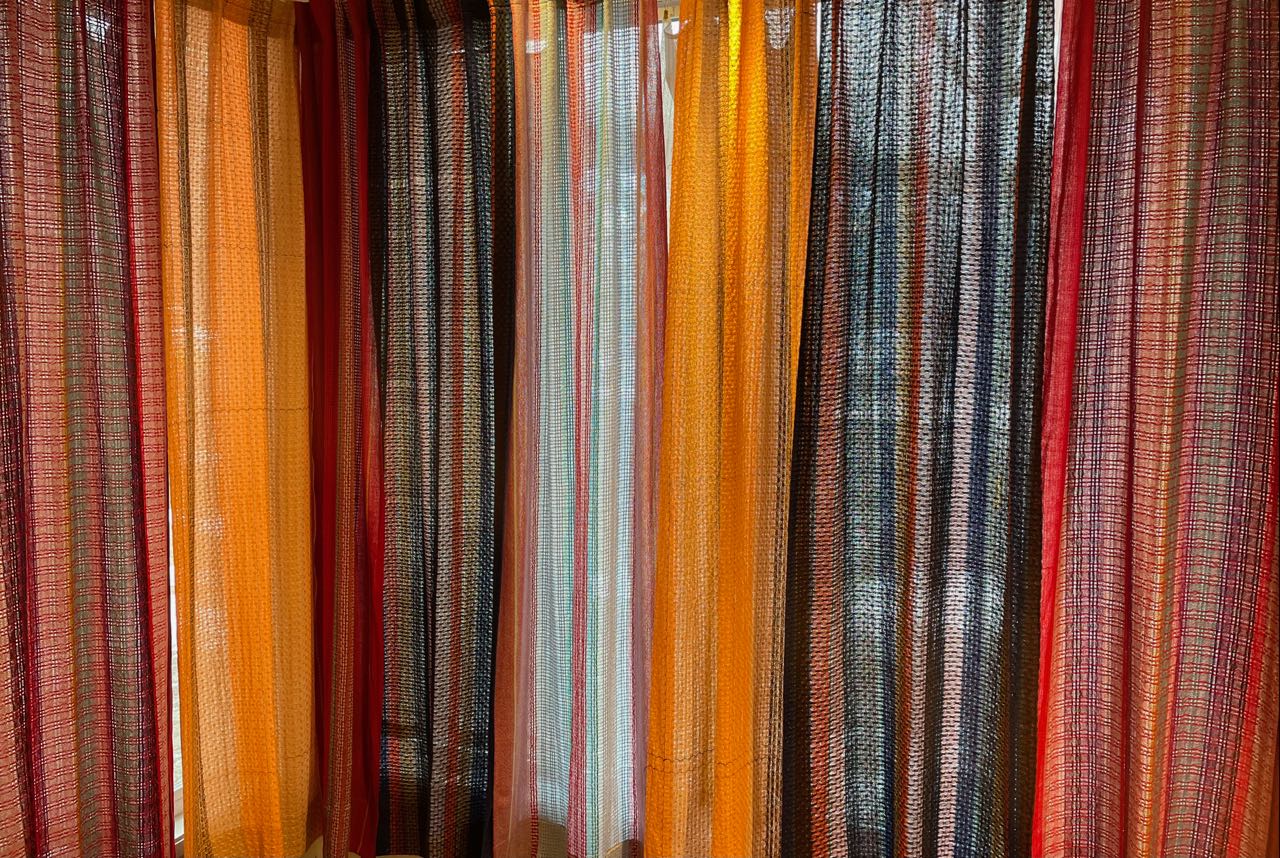
draperies, handwoven lace structure cotton linen bamboo and rayon metal curtain rod and hand lathed wooden finials, 2023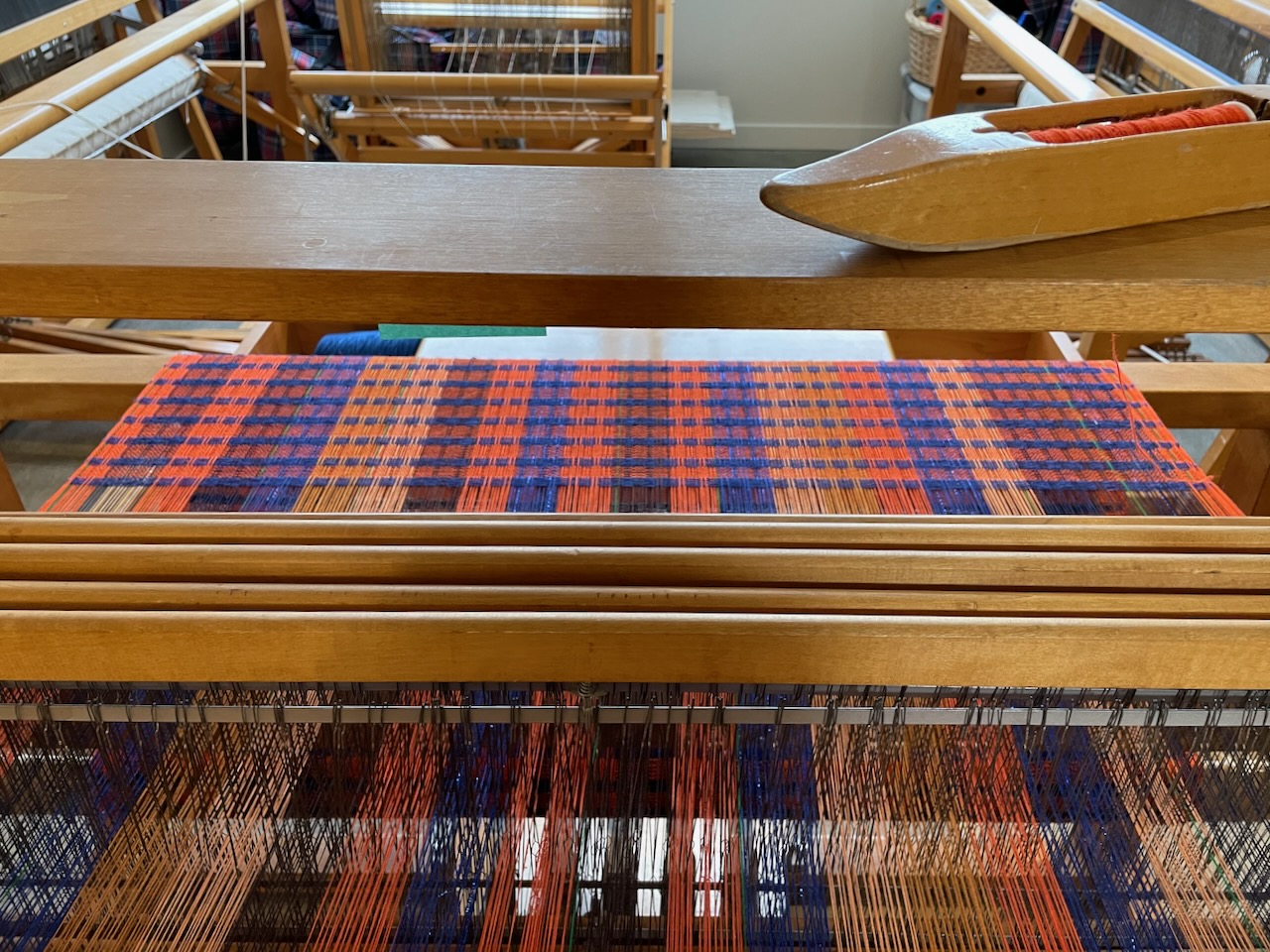

weaving the cloth for the drapery panels
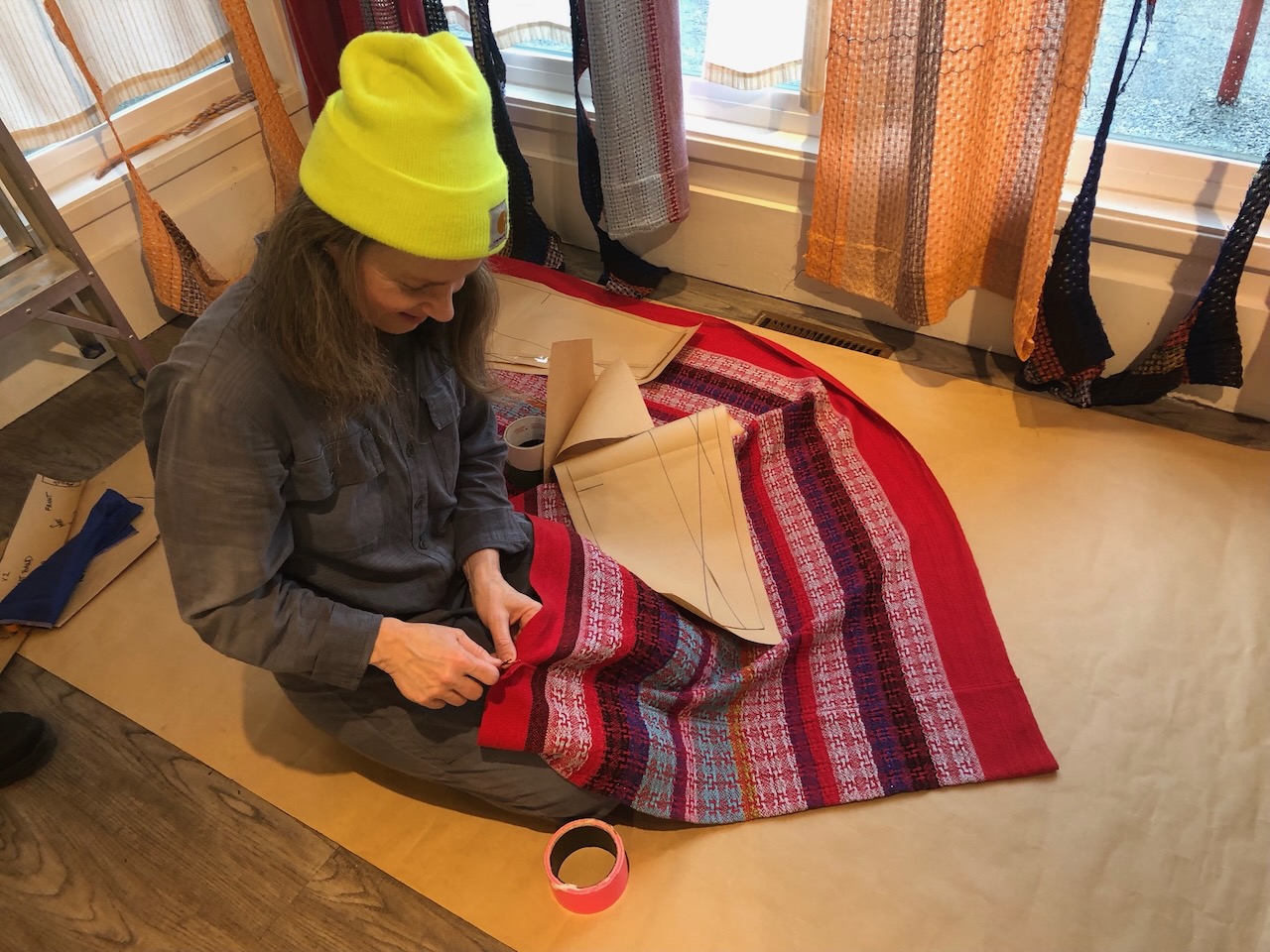
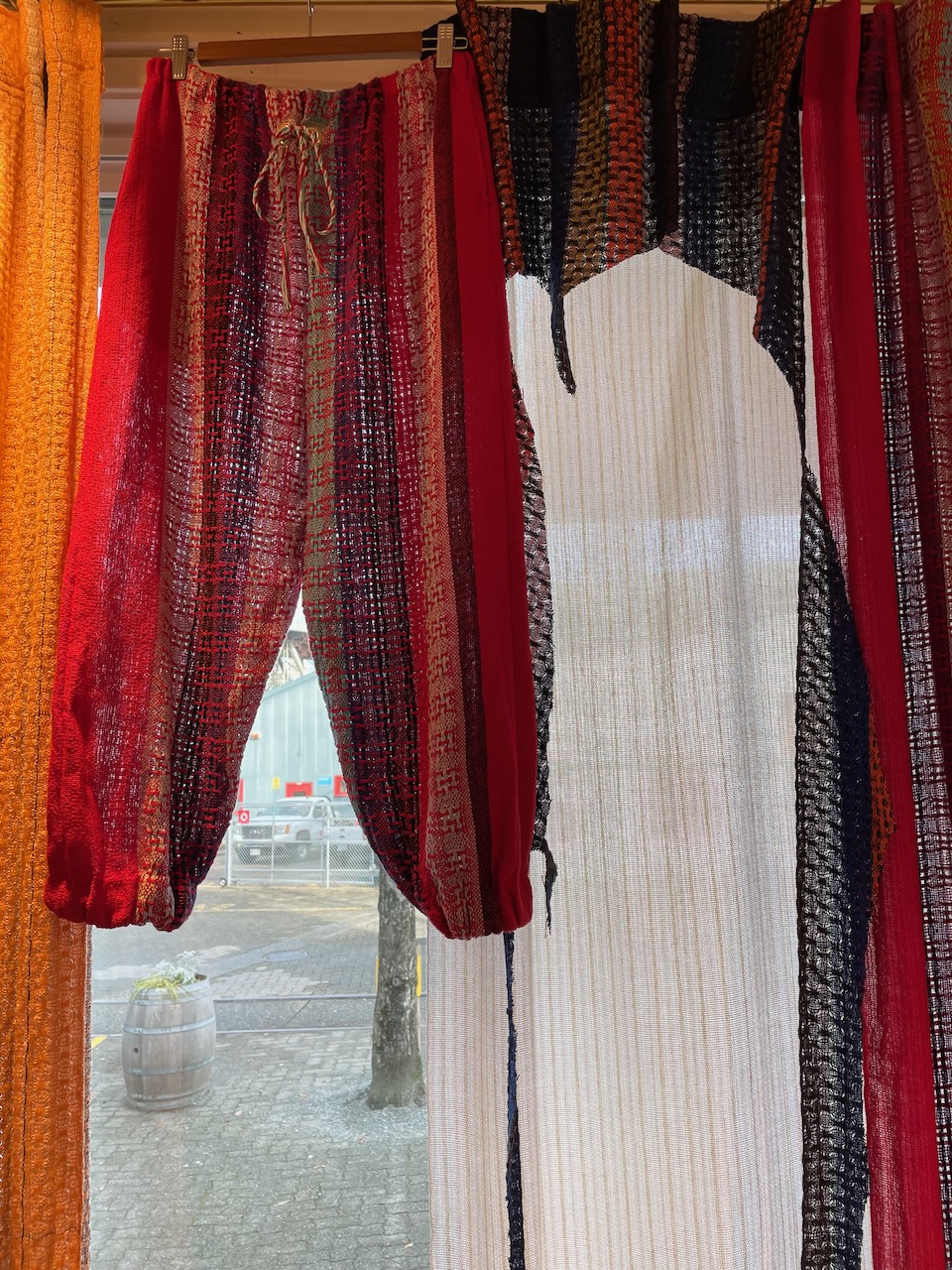
making the draperies and making the duds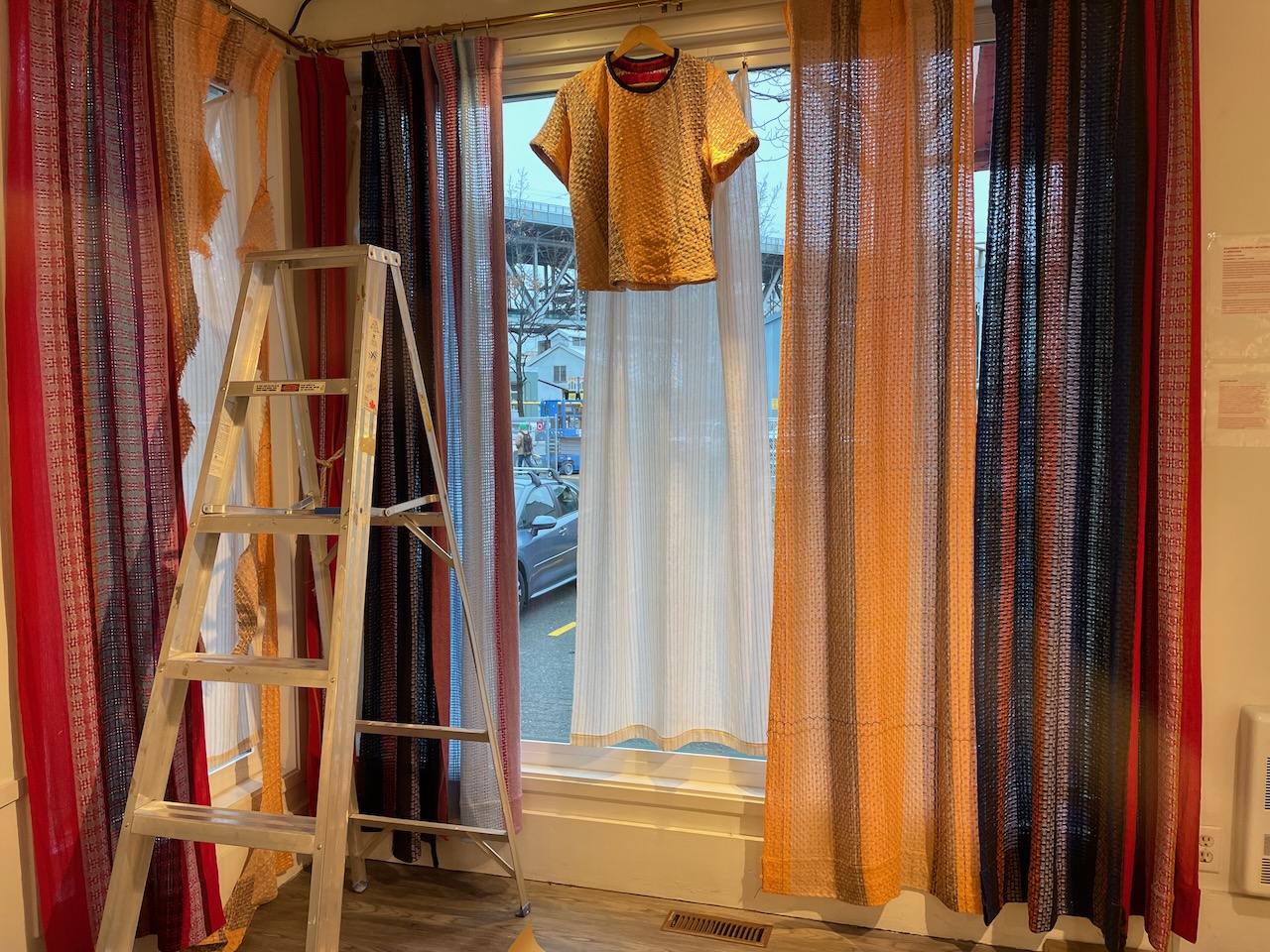
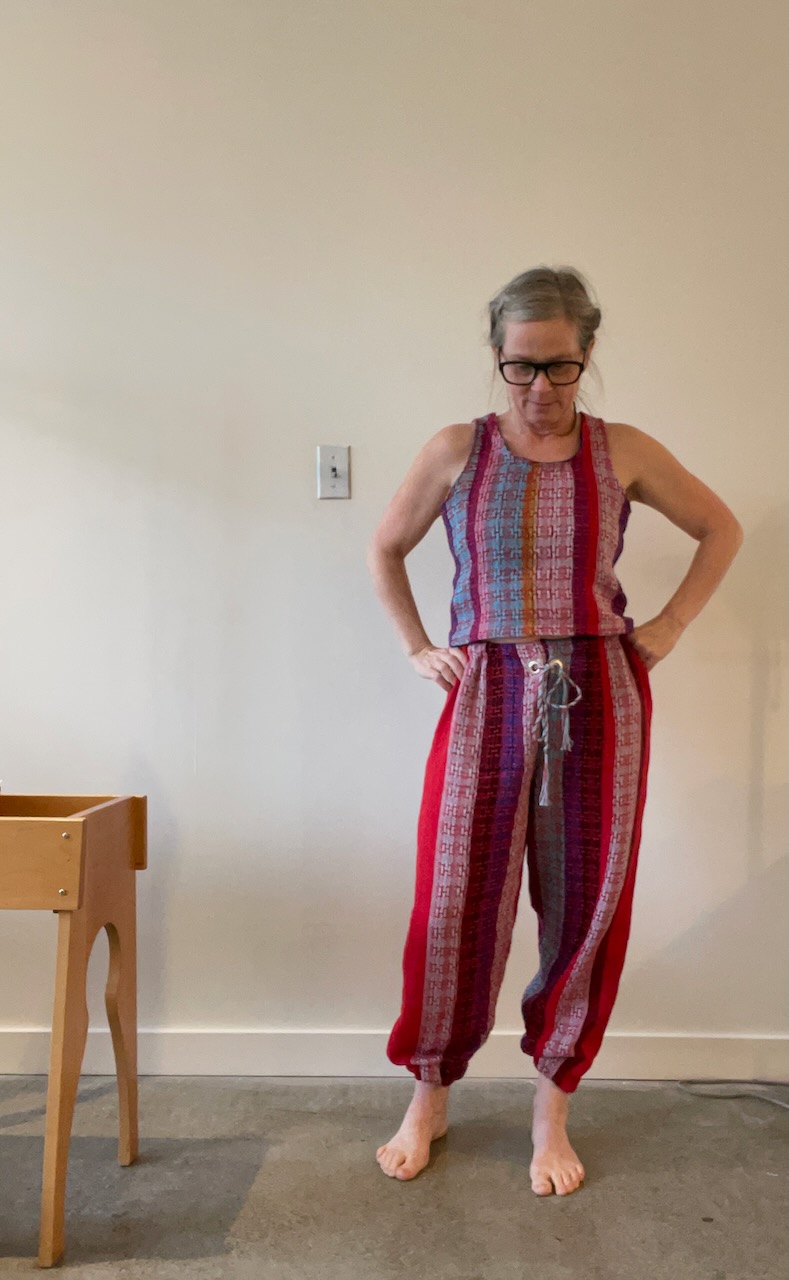 the transformation from drapery to dud
the transformation from drapery to dud
Artist Talk 2023
Draperies to Duds: an accelerated enactment of a lifecycle
The most ubiquitous items in our closets have the most mysterious provenance.
Weaving textiles on a floor loom best reflects my ongoing exploration of trends in fashion and interior decoration as well as the accelerated rate of change within these categories. I am keenly interested in how we choose to represent ourselves, hide who we are, the costs associated with those decisions, then choose ( and ultimately ) compromise our self expression. We rarely have the opportunity to witness or partake in the production process behind how these wardrobe items are produced and become available to us as consumers.
The labour associated with our beloved and utile textiles is invisible. Occasionally we may have a curated glimpse into the designer’s life for the purpose of marketing, but the labour behind the textile ( the production line, the assembly and piecework ) is opaque. As trend cycles compress and productivity demands accelerate, work hours increase, resulting in over stock, textile waste and exhausted, exploited labourers.
Preoccupied and concerned with trends and their side effects, I ask myself what is current in fashion and why. I set about designing window draperies in huck lace, which in itself was trending in my social media feed when I conceived the idea. Once the draperies are hanging in the window I transform the window dressing into new outfits by cutting away at the installed drapery panels, performing a hopeful action as I attempt to create a new look for myself. Ultimately, what we are trying to achieve when dressing and decorating; a transformation. Attempting to create garments from draperies, athleisure wear garments for this exhibit; leggings, crop tops and tank tops, illuminates and exaggerates our need to update ourselves by dressing in the current models of style. This window installation project offers an opportunity to work through my preoccupations with labour, trend cycles, self representation, systems of production, process, the circular nature of fashion and the shortened cycles these occur in, as well as the excess created by our consumer demands.
I have always admired the colour choices and colourful combinations my grandmother made when designing her hand crafted quilts. She cut up and deconstructed her polyester two piece pant suits to create these bold, colourful and well constructed quilts. Much of my childhood was spent in her living room, which contrasted greatly from her quilts and outfits. Her colour palette for her garments diverged from her home decoration, which I now know to have been the Colonial Revival style. Grandma wore bright saturated colours, the colours achieved through polyester textile production. Recalling the colour palette of her interior decoration, it was muted; brown, orange, mustard. My colour choices for the huck lace draperies for the window installation are taken directly from colour combinations my grandmother used in her quilts, which are a reflection of her personal dressing style. My huck lace weave, although woven with a blend of cotton, linen and bamboo, not polyester, is an open enough weave structure to allow stretch and movement within the fabric for the wearer. The weave draft creates a small square pattern of grids in the cloth - shapes that will allow light to come through and enhance the draft structure when the textile is in window dressing format and allow stretch when in garment format.
My rumination on the textiles which surround us, the need to enact the process of creating, destroying and rebuilding some of the most common objects in our lives, and doing so in a somewhat performative way is a response to the textiles and ideas I’ve noted above, as well as my love of interiors and outfits, current and past. I have three of my grandmother’s quilts. I’ve imitated the colour palette of the quilt tops and those colours are reflected here, in the draperies, in the gallery. As the exhibit progresses and I’ve constructed outfit pieces, the viewer may encounter me wearing the pieces while in the gallery space when I am in attendance. Unlike the commercial garment production industry, I cannot say how many pieces I will create or meet a quota. I can only hope to create an item you or I will feel good in, if not amazing in, as well as know the provenance of that garment.
When the viewer enters the gallery they will see the gallery shop, the gallery, and to the right, the window draperies. The draperies are hung from curtain rods and finished with hand lathed wooden finials at the end of each rod. These textiles are handwoven on my floor loom, sewn, washed, cut, pleated, hemmed and attached to the necessary hardware to hang. Initially the drapery installation will simply appear to be curtains, maybe even made in poor taste, but they will be functional. Once they are hanging as curtains in the gallery I begin cutting away the necessary shapes to create the garments. The gallery assistants may continue to open or close the curtains as needed. Remaining intact will be the handwoven curtain under layer, which acts as a “sheer” to help dilute the sunlight and provide an extra layer of warmth against a window draft. The under layer also works to frame the shapes I’ve cut out for the garment. The audience may find me removing a curtain panel or re-hanging a panel during any of the gallery’s open hours. The audience will not see my studio work or witness my sewing or hand weaving of replacement drapery panels, however, I will be readily available to anyone inquiring about the process.
The fabrication and presentation of Draperies to Duds is influenced by a concept put forth in a Rachel Kushner novel, textile waste issues addressed by Harriet Adjabeng, influential Hollywood films featuring home made outfits, interior decoration, and the hidden systems of production behind consumer goods.
Rachel Kushner’s title character Romy in her novel The Mars Room, upon imprisonment in a correctional facility, reflects on her prison assignment as a production line sewer. The prisoners are sewing what will become sandbags, to be filled with sand further down the production line. Three sides are sewn and the top is left open to fill. The pay is by cents for this piece work, but what Romy finds most unsatisfying is the inability to complete the entire sandbag. The work lacks the satisfaction of completion as it is a production line process and passed from worker to worker for ultimate efficiency. One never experiences a sense of fulfilment from their work, the task taken away prior to resolution. Harriet Adjabeng of Ghana’s Sustainable Fashion League for Ghana’s Youth Environmental Movement reporting from second hand clothing markets in Ghana explains how, we in the global north dispose of our heavy weight textiles, such as out of style and unwanted draperies, in shipping bundles headed for the global south. The bundles are purchased based on their grading, however the contents are hidden. Only after purchase do buyers learn the contents. As the bids are made blind, by grade number only, we in the global north are able to hide and dispose of our unwanted textiles, through our second hand donations system, resulting in a majority of unusable textiles bundled with the smaller portion consisting of just slightly out of fashion garments.
The ideas at the core of this presentation and the ability to explore and enact these ideas in installation format at Craft Council BC on Granville Island is fitting. On the island and at Craft Council BC one expects to find products created from start to finish by the artist. Granville Island historically was created as a location dedicated to manufacturing. At Craft Council, Draperies to Duds, the most ubiquitous items in our closets, will have a less mysterious provenance.
Weekly posts from the exhibition:
Week 1
Trust my Gramma.
The colours we wear are personal decisions, but the colours we don are a culmination of the industrial system behind fashion, textile production and the marketing of those items. I can barely fathom the complexities of that global market, and how it ends in my trousers, or pant purchase that is. Too complex to tackle in my Draperies to Duds: an accelerated enactment of a lifecycle blog, I can however, focus on an element of that industry I enjoy and always appreciate, even placing wagers on. That is, the naming of the colour of the year! The announcement for 2023 came out yesterday, December 1st. I am overjoyed at their selection, as I had already been playing with the reds and magentas within this colour wheel.
The drapery colours in this installation are copied from the colours my grandmother used to make her quilts, which she made prolifically, for everyone in the family. My Grandmother wore the very saturated colours of that early iteration polyester, the leisure pants suit. She used those suits to make the quilts. Thanks to Gramma’s fickle taste, much love to give, and a pressing need to never idle, I became the benefactor of three of her quilts. They have fabulous colour combinations, and yucky fibre content. I was able to explore her colour combinations over the length of about 55 yards of hand weaving. We don’t have individual input in choosing the colour of the year, upcoming industrial textile production, or the fibre content in those textiles, but we can decide whether we opt in, or not, that is personal. Many of us would like to shake off this past year, dump our veri-peri’s and wrap ourselves in 2023’s viva magenta. Whether you add viva magenta to your life, or you are doubting it will fit in with the other colours, be assured, as I just learned, over fifty five yards of hand weaving, viva magenta and veri-peri look great together, just like my Gramma’s quilt. You can trust your grandmother, or my Gramma.
Week 2
Wearing my art on my sleeve.
Taking the scissors to the draperies was distressing. I knew I was about to render the drapery into a potentially ugly and no longer utile item. I could not be sure what the curtain would do once I began cutting the patterns out. I hoped they’d resemble a human shape. The hanging sheers behind the draperies behave as undergarments, providing modesty for the gaping holes. A performative exhibit and the possible public failure has me on tender hooks. I have limited experience sewing and pattern making and I struggle to find the art in the exhibit. I therefore look to the analogy within the draperies; the textile provides comfort and protection from outside. The destruction of the draperies renders them useless, stripped of their effectiveness. The fabric awaits its new use, rebuilt, to provide comfort and protection again, in the form of a garment. Will art arrive in the objects? Did I destroy the art, objets d’uds? For the time being, I’ll be wearing my art on my sleeve.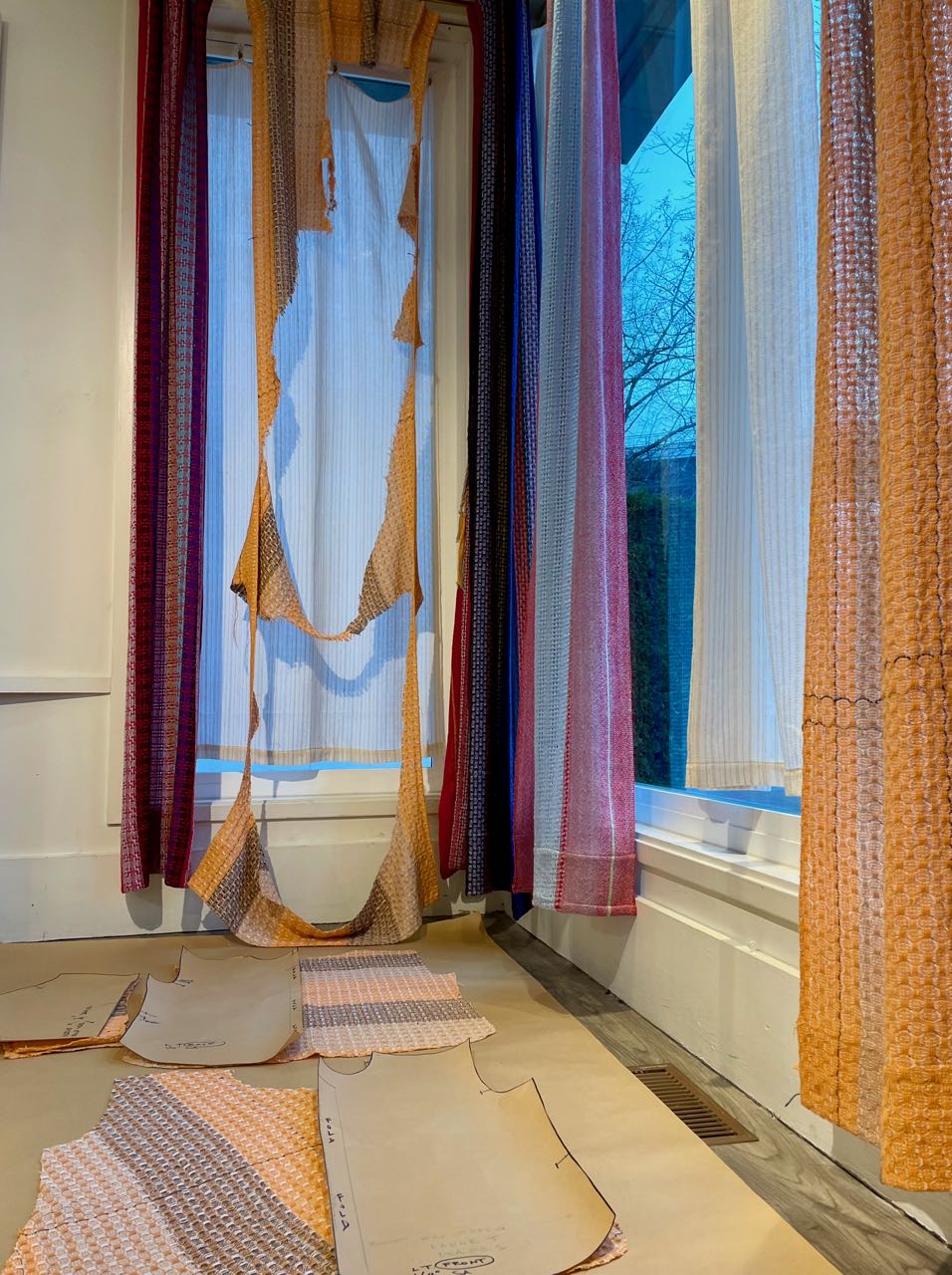
draperies, handwoven lace structure cotton linen bamboo and rayon metal curtain rod and hand lathed wooden finials, paper, various dimensions 2022
Week 3
Flying by the seat of my pants. Like a character in a fairy tale, I carry out my live action harvest of cloth from draperies into the fourth week of this exhibit. And, very much resembling the fairy tale parable, I’m enacting that repetitive chapter, the chapter where the protagonist labours. Each week consists of; designing and creating a new pattern from a much loved and pre-worn personal garment, disabling the draperies in the gallery, cutting out the pattern, re-hanging the draperies, taking the cloth to my studio, serging the cloth pattern pieces, and constructing the new garment while planning the weave sett and palette for the upcoming replacement drapery.
I’m delighted to report, when trying on the last piece I had sewn up, it worked! The fairy tale played out. I looked in the mirror and was transported; mentally, seeing myself in new garment with shortish shorts, tanned and slender legs, on a large red and white checked picnic blanket, bright green grass, friends, wine and laughter. In short, a 1990’s Benetton ad. Youth regained, friendships and supports entrenched, Covid and weather not an issue. It was about 1: AM in a snowstorm. Next up, pants.
Draperies to duds involve vast output of physical and mental labour each week. Every consumer textile shares a similar story, although enacted through many hands. The textile industry reads much like a fairy tale, capital gains accumulate for very few, gains made by exploiting our desire to transform, to decorate our soul, to demonstrate who we are or we want to be, how we want others to see us. Meanwhile, I’m cutting out the pants pattern. I have not made pants before. I’m tracing a much loved pair of trousers and struggling at the logic of a pants pattern, pre-construction. The story loops, lessons go unlearned, labour is undervalued, and I’m flying by the seat of my pants.

t-shirt from draperies, drapey of handwoven lace structure in cotton linen bamboo and rayon, pair with warm weather fisheman sandals short shorts rosé and good friends, loose fit, 2022
Week 4
The final curtain.
I’m finishing up the last panel of hand woven lace curtain, performing the continuation of the cycle. Ideally, in aid of the concept behind draperies to duds: accelerating the enactment of a textiles lifecycle, the garments would go to the charity bin. However, needs of the gallery and artist being the reality, they will be available at retail prices. Unlike the items we see in multiples in department stores, the garments are one of a kind, and therefore perceived as items of higher value, priced higher than the vast racks of athleisure wear in department stores. It’s a privilege to craft here, in the global north. Valuable skills are retained as we continue a tradition, but it’s not a necessity, as we have outsourced production of most things we want or need.
So, why labour? To demonstrate?
The performative aspect of the this exhibit feels like a demonstration, a protest and a critique, at odds with my first love; outfits on people, what they’re wearing and why, textiles. Throughout the exhibit I’ve mainly been thinking about labour. The who, where and why’s of production. As stated, the performative aspect of this exhibit does feel like a demonstration,
or do I mean demo?
This dichotomy has me listing other contrasts within the exhibit: The curtains are distressed, but clean, new fabric conveying fresh decay. We are freed up by the machines, which create other limitations and forced compromises. Consumerism provides a sense of control in that moment, but it’s only temporary, with lack of control looming large. Material literacy is important yet undervalued. A reversal of transfiguration. Make a useful item, destroy it to create another useful item, that is only somewhat useful, for a limited length of time.
And there it is, the final curtain, but not the last drape. Or is that the drape but not the final curtain?